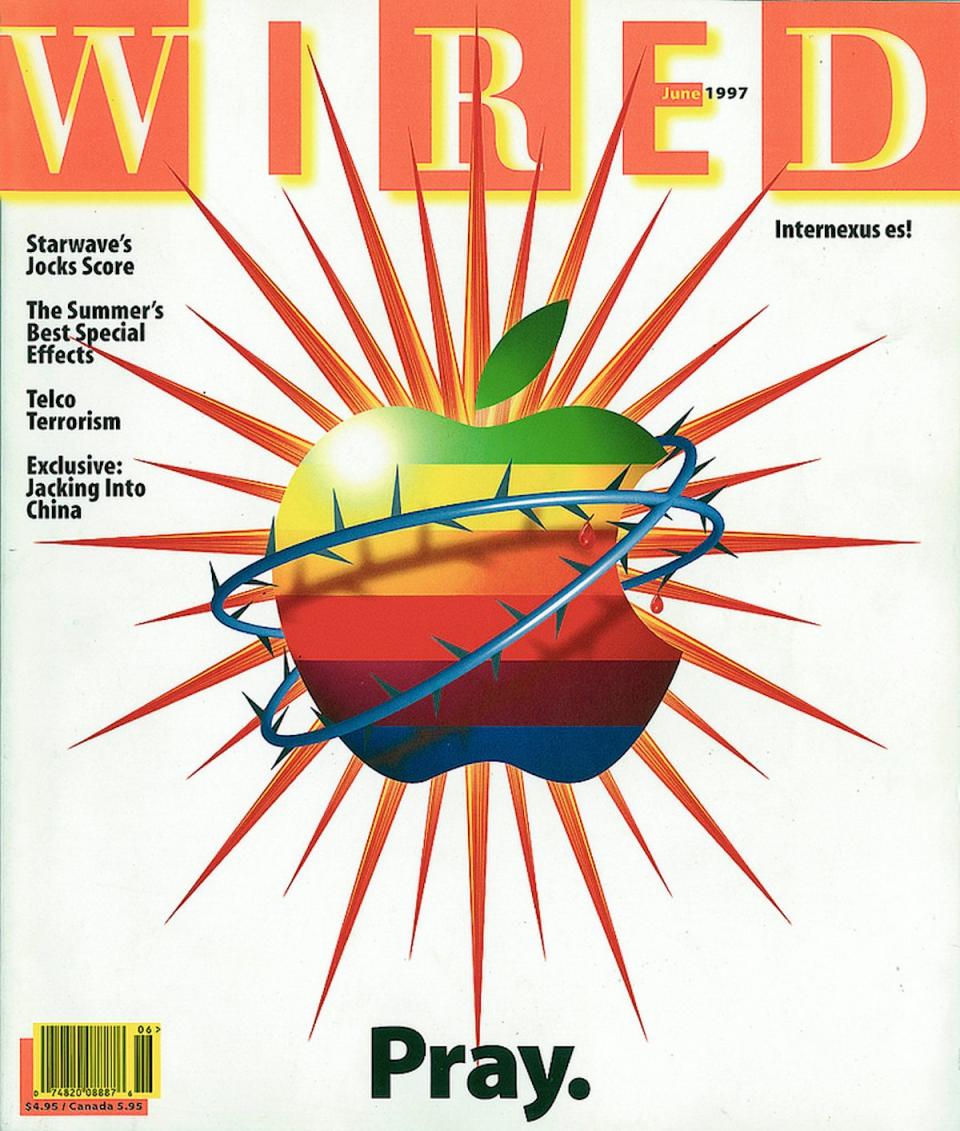All the things Wired got hilariously wrong in its legendary 1997 story on how to ‘save’ Apple

Wired
In June 1997, tech magazine Wired published a legendary issue about Apple, and the problems facing the then-struggling Cupertino technology company.
Founder Steve Jobs had been kicked out years earlier (although he had just rejoined after Apple acquired his company NeXT), and Gil Amelio was at the helm. Microsoft was easily dominating the PC industry. The article was one of the best-read stories in tech at the time and came packaged in a cover that remains a classic.
Wired’s editorial staff gave 101 suggestions on how to “save Apple.” Most of the ideas were prescient — running a great image campaign, developing a better app ecosystem, giving Steve Jobs “as much authority as he wants in new product development,” and simplifying its PC product line, for example.
But some their other suggestions were dead wrong.
SUGGESTION #1: “Admit it. You’re out of the hardware game. Outsource your hardware production, or scrap it entirely, to compete more directly with Microsoft without the liability of manufacturing boxes. “

REALITY: Apple went on to produce some of the most successful consumer electronics of all time. Its Macs, MacBooks, iPads and iPhones have sold hundreds of millions of units, and are a driving force for innovation in the industry.

SUGGESTION #2: “Straighten out the naming convention. Link model numbers to processor speed. When buying a 3400 laptop computer, what, exactly, are you getting? Unless you study the brochures, you don’t know how it compares with its competition. On the other hand, Wintel talks explicitly about processor speed. It’s a Pentium 200-MHz box.”

REALITY: Rather than talking “explicitly about processor speed,” Apple has made its naming strategy as simple as possible — the ‘iPhone 6,” the “MacBook Air,” etc. As a result, its products are far more memorable than its competitors’.

SUGGESTION #3: “Sell yourself to IBM or Motorola, the PowerPC makers. You can become the computer division that Motorola wants or the alternative within IBM. This would give the company volume for its PowerPC devices and leverage for other PowerPC offerings.”

REALITY: With a market cap of $740 billion, Apple is now four times the size of Motorola ($12.6B) and IBM ($168.7B) combined. It even has enough cash lying around to buy IBM outright.

SUGGESTION #4: “Work on ways to make your lower-end models truly upgradable. Giving customers a definite, manageable upgrade path will attract and hold customers. People need to be able to upgrade and expand, so they don’t feel dead-ended every time Apple changes its mind.”

REALITY: Apple has steadily made its devices less and less upgradeable and customisable. When people realised the iPhone battery couldn’t be changed, there was uproar, but much of the industry subsequently followed suit. You can’t even upgrade the RAM in new MacBooks. People may complain, but it doesn’t stop them buying the devices.

SUGGESTION #5: “Bring back John Sculley. He would provide a convenient whipping boy.”

REALITY: When Sculley was CEO, the company languished and lost its way. Under Steve Jobs, and subsequently Tim Cook, Apple has become the largest and most profitable company on the planet — by a significant margin.

SUGGESTION #6: “Invest heavily in Newton technology, which is one area where Microsoft can’t touch you. Build voice recognition and better gesture recognition into Newton, making a new environment for desktop, laptop, and palmtop Macs. Newton can also be the basis of a new generation of embedded systems, from cash registers to kiosks.”

REALITY: The Newton, developed while Steve Jobs was not at the company, was a commercial flop, with significant technical issues. While the iPhone did later succeed in a similar area, that was 10 years later, and only made possible by a decade of developments in technology.

SUGGESTION #7: “Abandon the Mach operating system you just acquired and run Windows NT kernel instead. This would let Mac run existing PC programs.”

REALITY: At the time, Microsoft had the richer app ecosystem, but 17 years later, the opposite is true. Apple stuck to its guns, succeeded, and now Microsoft has even announced that its new devices will run iOS and Android apps, so sparse is its modern selection.

SUGGESTION #8: “Speed sells. Push your advantage on the speed of the processor. This summer, you’ll release Macs using 450- and 533-MHz processors. Your lead over Intel will be remarkable. Brag about this.”

REALITY: Apple’s devices rarely have the best technical specifications on the market these days. For the price, you can get a far more powerful Windows machine. But people still buy Apple — because it’s not the “speed” that sells, it’s the entire user experience.

SUGGESTION #9: “Price the CPUs to sell. Offer novice users the ability to enter the Mac market at a competitive price point and move up the power curve as their level of sophistication increases. The initial price keeps new buyers away. “

REALITY: Apple shows little interest in the lower end of the market. Instead, it has targeted the high-end, where the majority of the profits are. And it has worked really, really well — in Q4 of 2014, Apple raked in 89% of all profits in the entire smartphone industry.

SUGGESTION #10: “Reincorporate as a nonprofit research foundation. Instead of buying computers, customers would buy memberships, just as they do in the National Geographic Society. They’d receive an Apple computer as part of their membership perks. Dues would be tax-deductible. Your (eventual) profits would also be tax-exempt, and the foundation could continue its noble battle to keep Microsoft on its toes.”

REALITY: Nonprofit? At the end of 2014, Apple had the most profitable quarter of any company *ever*.

Now read:

Bill Gates made these 15 predictions in 1999 — it’s scary how accurate he was »
The post All the things Wired got hilariously wrong in its legendary 1997 story on how to ‘save’ Apple appeared first on Business Insider.

 Yahoo Finance
Yahoo Finance 
